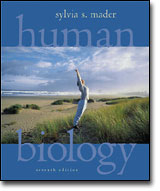|
 |  Human Biology, 7/e Dr. Sylvia S. Mader
Human Evolution
Chapter Outline
23.1 Origin of LifeA chemical evolution produced the first cell(s). 462 |
 |  |  | 23.2 Biological EvolutionAll living things are descended from the first cell(s), and therefore they share a cellular structure and a common chemistry. 463Darwin gathered evidence for common descent and proposed a mechanism for natural selection. 464The process of natural selection accounts for the great diversity of living things. 465 |
 |  |  | 23.3 Humans Are PrimatesHumans (Homo sapiens) are in the order Primates, which are mammals adapted to living in trees. 466Primate characteristics include an enlarged brain, opposable thumb, stereoscopic vision, and an emphasis on learned behavior. 466 |
 |  |  | 23.4 Evolution of AustralopithecinesAbout 3 mya,1 several species of australopithecines (the first hominids) evolved in Africa. The australopithecines had a small brain, but they walked erect. 468 |
 |  |  | 23.5 Evolution of HumansAbout 2 mya, Homo habilis, the first hominid to make tools, was most likely a hunter, and may have been able to speak. 469About 1.9 to 1.6 mya, Homo erectus migrated out of Africa and was a big-game hunter that possessed fire. 470The out-of-Africa hypothesis says that modern humans evolved in Africa, and after migrating to Europe and Asia (about 100,000 bp2), they replaced any Homo species there, including the Neanderthals. 471Cro-Magnon is the name given to modern humans who made sophisticated tools and definitely had culture. 4721mya = millions of years ago 2bp= before present |
|
|



 2002 McGraw-Hill Higher Education
2002 McGraw-Hill Higher Education

 2002 McGraw-Hill Higher Education
2002 McGraw-Hill Higher Education